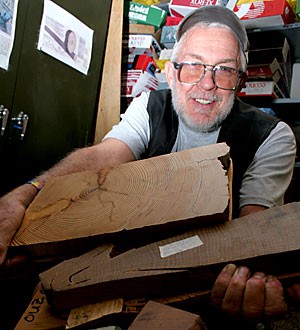Just a few stories below the stadium where raucous fans cheer on the Wildcat football team, UA scientists are hard at work in the world’s largest and oldest tree-ring research laboratory, chipping away at problems like global warming and cancer.
“”(The lab) helps us understand climate, human behavior, aspects of landscape change, and any number of things that tree-rings can provide information about,”” said Rex Adams, research specialist at the Laboratory of Tree-Ring Research.
Tree-rings are annual growth markings on cross-sections of trees that assist researchers in a multitude of studies.
The tree-ring lab has been located around and under the stadium since 1937 and can be recognized by the small white letters on a blue door that mark the main office of the lab.
Check out the Wildcat’s science and technology feature every Wednesday right here!
From there, the research facility unfolds through a series of corridors and stairways like a secret passageway under the stadium. This is where most of the boxes of ancient tree sections are kept with color-coding for different studies.
Red boxes hold tree-rings with fire scars; blue ones hold climate study sections; green is for ecology studies and brown is for Sequoias studies.
“”What we have with tree-rings, because of the absolute annual resolution, is two things,”” Adams said. “”One is that events that have happened to trees (like fires) and the second thing is processes like climate.””
One of the most important studies is based on recognizing fire scars, which are a deep brown color inside the tree-rings. This can imply climate change in the past that gives researchers a jump on what will happen in the future, Adams said.
Tom Swetnam, director of the Laboratory of Tree-Ring Research, said this gives them the ability to forecast a possible fire season.
With the ability to forecast a tougher fire season, firefighters can be more prepared or be used in other places accordingly, Swetnam said.
“”In 1748, there was probably a fire in every forest in the west because 1747 was an El Nino year,”” Adams said.
Research through tree-rings has shown that the year after El Nino is generally dry and the extra vegetation that grew as a result of the previous year will dry up and cause more fires, Adams said.
Studies done at the UA Laboratory of Tree-Ring Research has also led to hints of global warming.
Adams said the last 10 years of the 20th century were the warmest decade of the past 1,000 years. This was found from tree-ring research by Malcolm Hughes, a professor of dendrochronology, and others.
As early as 1850, trees began to grow more because of longer warm-weather seasons, Adams said.
Deeper in the heart of the west part of the stadium, researchers have dated sections of trees used for studies as far back as 300 B.C., said Jim Parks, research specialist at the lab.
The oldest sections are either charcoal pieces or pieces found in places like cliff dwellings where walls were able to preserve the wood.
After the wood is dated, it can be used for other studies, like a project to determine whether pollution plays a role in causing leukemia in children. Annual growth of tungsten and cobalt in trees, along with studies of these pollutants in air, soil and water, may have important implications of the environmental effects in communities, Adams said.
Paul Sheppard, a principal researcher in this area, recently left for Washington, D.C., to present his research and acquire more funds for research on pollutants in tree-rings.
The wide range of research at the tree-ring lab is match by a wide range of visitors, like Alejandro Casteller, who has traveled from Argentina under the Houry Fellowship to learn the techniques at the UA.
“”Visitors from all over the world come here to learn our methods of study,”” Adams said.
The methods include a long process of extracting the right part of the tree to get a clear picture of the rings. One of these methods is “”coring”” a tree, where researchers take string-like cross sections of the tree. The string, which is not much wider than a centimeter, is attached to a stick.
“”You want to mount them (strands of tree-ring cross-sections) and sand them and once you have a really fine surface, you can date the rings,”” said Julie Wong, research assistant to associate research professor Ramzi Touchan. “”You use the humidifier to unwind it pretty much because when you core the tree it is not straight.””
It dries for about 24 hours before researchers are able to use the measuring stage, which is a microscope attached to a computer that allows measurements to be taken accurately, Adams said.









